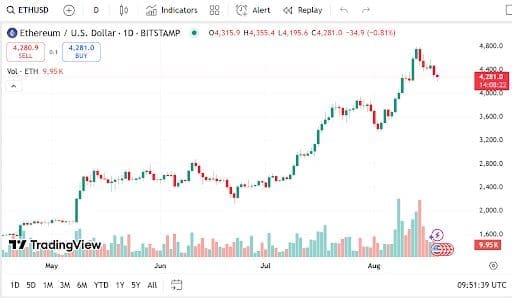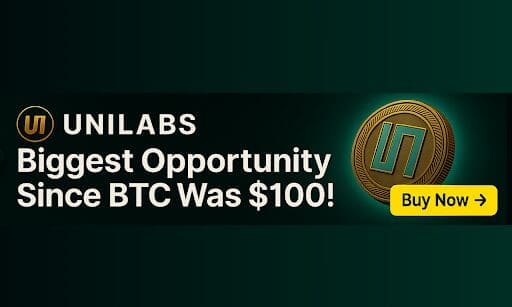Bitcoin has been held above the $106,000 support zone, while Ethereum remains the second-largest cryptocurrency with over 17% of total market cap.
The Ethereum price at current levels is being perceived as either an accumulation phase or the start of a new breakout. On-chain indicators show rising exchange inflows, implying profit-taking, but derivatives funding is neutral.
Meanwhile, Unilabs Finance (UNIL) is picking up steam with its AI-generated strategies, positioning itself as a potential outperformer to ETH in risk-adjusted 2025 returns.
Ethereum Price Figures Reflect Mixed Sentiment
The Ethereum price currently stands at $4,268.05, down 0.75% for the day. Despite the relatively small drop, the asset boasts an astronomical $515.43 billion market cap. Volume remains strong, with $45.89 billion in 24-hour volume, a modest 0.93% increase. The figures confirm ETH remains one of the most liquid cryptocurrencies, only second to Bitcoin in market scope.

Source: TradingView
Despite this, the figures indicate ongoing uncertainty. Ethereum price has shown strength around the $4,200-$4,300 region, but the inability to find strong upside momentum has some traders cautious.Traders are now more frequently pointing to scalability problems and persistently high gas fees as possibly limiting ETH profits.
While Ethereum’s long-term development plan involves upgrades that will render fees lower and throughput greater, investors seeking asymmetrical upside may be tempted to diversify into projects that are already delivering innovative solutions.
Ethereum’s Weak Spots Open the Door for Unilabs’ AI Advantage
Ethereum price has traditionally benefited from its dominant network effects, with decentralized finance (DeFi), non-fungible tokens (NFTs), and Web3 development largely built on its infrastructure. However, chinks are visible.
Competing layer-1 blockchains are offering faster, cheaper, and more scalable platforms, eroding Ethereum’s developer base. While institutional demand for ETH remains strong, retail adoption has slowed on account of usability barriers.
Gas fees have also become a major problem, as during periods of high activity, it can cost anything from a few dollars to transact on the Ethereum network, undermining its appeal as an open financial system for everyone.
As a result, some commentators think that without major upgrades, the Ethereum price can fall behind in 2025 as projects that tackle scalability and real-world adoption more directly.
Unilabs’ AI-Backed Growth Model Is Built to Outshine Ethereum
Unlike ETH, which relies to a great degree on network adoption cycles, Unilabs Finance is structured around real performance. The project manages over $30 million in assets under management (AUM) across four AI-powered funds: Bitcoin, Real World Assets, mining, and an adaptive basket.
This structure allows Unilabs to cycle through market regimes automatically, instead of relying on community hype or spec flow.
Unilabs’ token is backed by real yield, with net asset value (NAV) following in real time. Holders benefit from staking rewards that provide liquidity support, as well as a referral program that incentivizes user growth. Unlike meme coins or even older assets like ETH, where profit relies on market cycles, Unilabs provides continued value accrual.
The project already demonstrated the traction it has. Stage 6 of its presale sold out very quickly, introducing thousands of new holders. Stage 7 is now live at $0.0108, with 13.9 million USDT raised and 1.96 billion tokens sold. According to the pace of the previous rounds, analysts are convinced that it can close earlier than anticipated.

This gives urgency to early adopters to take allocations before the token lists on major exchanges.
For Long-Term Gains, ETH Is Solid, But Unilabs Brings the Real Edge
For investors, ETH vs Unilabs is not a question of substitution, but rather one of diversification. The Ethereum price should persist as a mainstay of the crypto universe, especially as upgrades are adopted and institutional acceptance becomes more deep-seated. Yet, the scalability challenges facing ETH mean its upside may be more incremental.
Conversely, Unilabs offers a dramatically different value prop: AI-managed funds, real yield, open NAV tracking, and multiple layers of revenue.
As 2025 approaches, investors balancing long-term security with growth potential may continue to hold ETH while also allocating to next-generation projects like Unilabs. Whether the Ethereum price climbs to new highs or stalls under structural limits, the rise of Unilabs ensures the competition for capital allocation in crypto is far from over.
Discover the Unilabs Finance (UNIL) presale:

